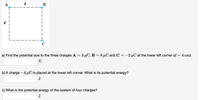Question

Transcribed Image Text:A
d
B
a) Find the potential due to the three charges A = 3 µC, B = 8 µC and C = -2 µC at the lower left corner (d = 4 cm):
V
b) A charge -4 µC is placed at the lower left corner. What is its potential energy?
J
c) What is the potential energy of the system of four charges?
J
Expert Solution
This question has been solved!
Explore an expertly crafted, step-by-step solution for a thorough understanding of key concepts.
Step by stepSolved in 5 steps

Knowledge Booster
Similar questions
- A particle with a charge of 4 µC is moved from a point with a potential of 100 V to a point with a potential of 200 V. What is the change in electric potential energy of the particle? A) 6x 10-4 B) 7 x 10-4 C) 8 x 10-4 (D) 9 x 10-4arrow_forwardA) Consider two metal plates separated by a dielectric material with a thickness of 4.5 cm. If the lower plate is at a potential of 9 V and the upper plate is at a potential of 0 V, what is the magnitude of the electric field generated between the plates? a) 200 V/m b) 40.5 V∙m c) 0.405 V∙cm d) 2 V/m B) What force will a proton feel in the uniform electric field from the question above? a) 32 N [towards upper plate] b) 3.2 x 10-17 N [towards upper plate] c) 6.48 x 10-18 N [towards lower plate] d) 64.8 N [towards lower plate]arrow_forwardThe drawing shows a square, each side of which has a length of L = 0.25 m. Two different positive charges 9, and gɔ are fixed at the corners of the square. Find the electric potential energy of a third charge q3 = -3.08 x 10-8 C placed at corner A and then at corner B. ЕРЕД 5.61e-7 ЕРЕВ - -4.79e-7 er B 91 = +1.5 x 109c q2= +4.0 x 10-°c D GO Tutorial Additional Materials M eBook 591 JAN 27 attv CO X Xarrow_forward
- Consider the figure shown below. Q1=1.5×10−9 C and Q2=−8.4×10−9 C. Charges Q1, Q2, and point '3' are all located at integer coordinates that you can read off of the graph. Assume the electric potential at infinity is zero. a) Calculate the electric potential at the location marked '3'.arrow_forward28. Consider the four particles shown, with q1 = -40.0 µC, q2 = -20.0 µC, q3 = 15.0 µC, and q4 = -25 µC. The square has sides of length a = 25.0 cm. %3! y B a A a 93 a) What is the change in the electric potential energy of the system of the four charges in the configuration shown in the figure if they were originally infinitely far away? b) Charges q3 and q4 are now moved to points A and B, respectively. What is the change in potential energy of the system after these charges are moved? c) What are the magnitude and direction of the electric field at the location of charge q4 due to the other three charges? d) What is the initial acceleration of the charge q4 due to the electric force exterted by the other three charges on q4 if m4 = 40.0 g? e) With what speed is charge q4 (with m4 = 40.0 g) moving when it is infinitely far away from the other charges? %3Darrow_forward.arrow_forward
- Consider a charge +q in a uniform electric field E. Work is exerted to move the particle a distance s in a direction pointing opposite to the electric field. By how much has the particle’s potential changed? A) Ed/q B)E/s C)Eqs D)Es E)none of the abovearrow_forward6) A +4.0 μC and a -4.0 µC point charge are placed as shown in the figure. Find the electric potential at points A and B, and find the electric potential difference AVBA (k = 1/4neo=9.0 × 10° N·m²/C²) B 0.30 m +4.0 μC 0.40 m -4.0 μC 0.30 m Aarrow_forward) The charge on the left with magnitude +4.0 C moves from point A to B where electric field points towards the +x axis as depicted in the figure on the right. The potential energy decreased by 40 J. It can be concluded that point B is Ax F = qË O a. 10.0 V lower in potential than point A O b. 10.0 V higher in potential than point A O C.40.0 V lower in potential than point A O d. 40.0 V higher in potential than point Aarrow_forward
- X 2) Four charges are arranged in the pattern shown. They have equal magnitudes of 1nC but have the signs shown. Three locations, labeled X, Y, and Z, are highlighted. 2 1 A 2 m 2 m 2 m i. The electric potential energy stored by this arrangement of charges is A. Positive Negative B. C. Zero ii. The electric potential at point Z (using the standard reference point) is A. B. A. 0 B. 1.5 V C. 4.5 V D. 6.0 V E. 12 V iii. The electric potential at point X (using the standard reference point) is 3.0 V 3.3 V C. 4.5 V D. 7.5 V E. 18 V 2 m 3 (+) 2 m 4 m 4arrow_forwardThree point size charges are situated in the points A B and C of an equilateral triangle where the length of the side is 8cm.qA=qC=2x10-8C qB=-2x10-8C A) What is the total force acting on each of the points A,B,CB) What is the electric potential in the center of the triangle?arrow_forward1. Two point charges q1 = +26µC and q2 = −17.5µC are 64 cm apart.a. What is the potential energy of the system of two charges?b. What is the electric potential at a point between them 24 cm from q1?arrow_forward
arrow_back_ios
SEE MORE QUESTIONS
arrow_forward_ios